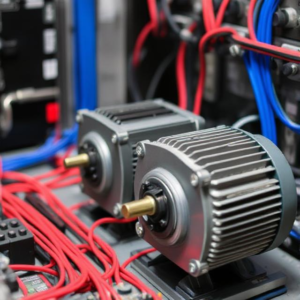Basic Electrical Circuits and Components
Introduction
Electricity is the flow of electric charge, and circuits are pathways through which this charge flows. Electrical circuits are made up of various components that control, direct, and use this electric charge to perform useful work like lighting a bulb, powering a fan, or running a motor. Understanding the basic components and how they work together in a circuit is essential for anyone studying or working with electrical systems.

Basic Electrical Components
-
Power Source (Battery/Power Supply)
A power source provides the necessary energy to push electrons through the circuit. The most common power sources are batteries (in small devices) and power supplies (in larger systems). A battery has two terminals, a positive (+) and a negative (-), and it pushes current from the negative to the positive terminal. -
Conductors (Wires)
Conductors, usually made of copper or aluminum, are used to connect different parts of the circuit. They allow the flow of electric current between the power source, the components, and back to the source. -
Load (Resistor, Bulb, Motor)
The load is any component in the circuit that uses electrical energy to perform work. For example, a light bulb converts electrical energy into light and heat, while a motor converts it into mechanical motion. A resistor is a load that resists the flow of current and is used to control or limit the amount of current in the circuit. -
Switch
A switch is a component that can open or close a circuit. When the switch is open, it breaks the flow of current, and when it is closed, the current flows freely through the circuit. -
Resistor
A resistor is a component that resists the flow of current, converting electrical energy into heat. It is often used to control the amount of current flowing in a circuit, ensuring that other components are not damaged by too much current. -
Capacitor
A capacitor stores electrical energy temporarily. It consists of two conductive plates separated by an insulating material. Capacitors are often used to smooth out voltage fluctuations and store energy for later use. -
Inductor
An inductor is a coil of wire that stores energy in the form of a magnetic field when current flows through it. Inductors are used to filter signals or smooth out current in power supplies.
Types of Circuits
There are two main types of circuits:
-
Series Circuit
In a series circuit, components are connected end-to-end, forming a single path for the current to flow. If one component fails or is disconnected, the entire circuit is broken, and no current flows. The current is the same throughout the circuit, but the voltage is divided among the components. -
Parallel Circuit
In a parallel circuit, components are connected in separate branches, creating multiple paths for the current to flow. If one component fails, the others will continue to work. The voltage across each component is the same, but the current is divided among the branches.
Ohm’s Law
Ohm’s Law is a fundamental principle in electrical circuits that relates the voltage (V), current (I), and resistance (R) in a circuit. The law is expressed as:
Where:
-
V is the voltage in volts (V),
-
I is the current in amperes (A),
-
R is the resistance in ohms (Ω).
This law helps to calculate one of the variables if the other two are known.
Electrical Power
Electrical power (P) is the rate at which electrical energy is used or produced. It is calculated by the formula:
Where:
-
P is the power in watts (W),
-
V is the voltage in volts (V),
-
I is the current in amperes (A).
Basic Circuit Diagram Symbols
To represent circuits on paper, we use standard symbols for each component. For example:
-
A battery is shown as two parallel lines (longer line for positive, shorter line for negative).
-
A resistor is represented by a zigzag line.
-
A switch is shown as a break in the line with a dot to indicate the switch.
Safety Tips in Electrical Circuits
-
Always turn off power before working on a circuit.
-
Use proper insulation for wires.
-
Never overload a circuit with too many components.
-
Use a fuse or circuit breaker to protect against short circuits.
-
Ensure the circuit is grounded properly to prevent electrical shock.
Summary
Electrical circuits are essential for powering devices and systems. A basic circuit consists of a power source, conductors, load, and control components like switches and resistors. Circuits can be arranged in series or parallel, and understanding these configurations helps in designing efficient systems. Key laws like Ohm’s Law and power equations allow us to calculate important values like voltage, current, resistance, and power. Working with electrical circuits requires safety precautions, such as turning off power and using insulated tools.











